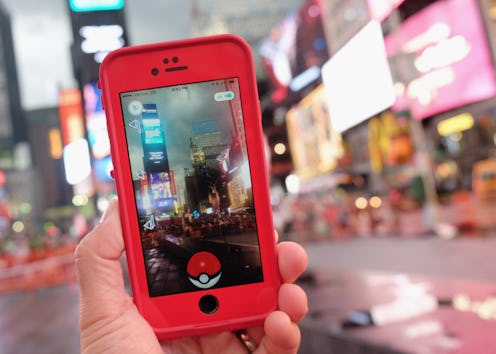As is wont to happen whenever something becomes popular enough to qualify as a full-blown cultural phenomenon, a huge number of apps and tools for “Pokemon Go” have popped up in the weeks since the augmented reality game’s launch. Some of them are kind of goofy; others, though, might be a little more useful than you might realize — and, in fact, might even be considered essential. From maps meant to help you better navigate the world while you track down that Dratini you keep missing to devices that will help you save your battery while you're battling, these nine picks while help you boost your Trainer game from ordinary to extraordinary. Also, they’re a lot of fun. Because fun is awesome.
A word of caution, though: Always be careful when downloading and installing third-party apps. As Tech Crunch recently reported, “Pokemon Go” malware is a thing, and a number of unofficial apps purporting to provide their users with cheats or tips are not only fake, but downright dangerous. Also, technically using third-party apps counts as cheating, according to the official “Pokemon Go” Trainer guidelines (“Methods of cheating … include at minimum the following: Using modified or unofficial software; playing with multiple accounts … ; sharing accounts; using tools or techniques to alter or falsify your location; or selling/trading accounts”). So… yeah. Tread carefully, is what I’m saying.
So what does a Pokemon Trainer need to become the very best? These things, to start. Trust me. And you’re welcome.
1. A Server Status Tool
Whether it’s an app or a website, the dedicated Trainer will want to keep some sort of tool that’ll tell you whether the “Pokemon Go” servers are working close at hand. A number of apps have popped up in the wake of the game’s launch, like Hooks; there’s also CCMCD, a website that will tell you what’s up with that little spinning white Pokeball you keep seeing on your map screen; and don’t forget good ol’ Down Detector, which quickly added “Pokemon Go” to the rotation of sites and services of which it keeps track (seen here).
2. Poke Radar
Available in both the iTunes App Store and Google Play Store, the free app Poke Radar helps you track down those hard-to-find Pokemon rarities. Like a lot of Pokemon-finding maps, the data for this one is user-submitted; as such, it’s not infallible, and you’ll want to take it with a grain of salt. Still, though — it’s useful to know where certain Pokemon may have been spotted; it might give you a better idea of where to go — or even simply what kinds of places to go — to find that Snorlax you’ve been waiting for your whole life.
3. A Good Map Or Two
Pokemapper and Pokecrew are both good picks for mapping actual Pokemon; PokeVision sounds like a popular option; and if you want a map of Pokestops and gyms, there’s one here. You also might try consulting “Ingress,” Niantic’s other augmented reality game — word has it that a lot of the map data in “Pokemon Go” was recycled from “Ingress,” so you might be able to identify hot spots for one app by looking at the other.
4. Pokeball Aimer
Having trouble actually, y’know, hitting the Pokemon you’re trying to catch with a Pokeball? The Pokeball Aimer might help. A 3D-printed case for your phone, it includes a guide that might result in more accurate aiming when you fling your Pokeballs at whatever you’ve got in your sights. If you have access to a 3D printer, you can download the design from creator Jon Cleaver’s My Mini Factory page and manufacture one yourself; if you don’t, you can order one ready-made from Cleaver on Etsy.
5. A Guide
Not to toot our own horn or anything, but Bustle has a wealth of “Pokemon Go” information available on it, from what leaves mean to whether it’s better to power up or evolve your Pokemon. If you prefer something in more of a database format, though, IGN’s “Pokemon Go” Wiki is pretty comprehensive. Since “Pokemon Go” doesn’t really come with an instruction manual, you’ll need to do the research yourself if you want information or help with strategies.
6. Battery Pack Pokedex
Like most apps that make heavy use of GPS, “Pokemon Go” can be a bit of a battery drainer. That’s where Nick Poole’s Battery Pack Pokedex comes in — not only does it help boost your battery (Poole says on his Sparkfun page that it adds an additional 2600mAh to his phone), but even better, it makes your phone look like an actual Pokedex while you’re at it. It’s a custom creation, so it’s not available for purchase; however, Poole has made the necessary files available on Github, so you can go ahead and make your own if you’re so inclined.
7. Pokeball Battery Pack
Pokedex not your speed? Go for a straight-up Pokeball instead. Created by Danielle Baskin, this plastic Pokeball holds a 5300mAh battery; it'll recharge a phone two to three times, significantly extending the amount of time you can spend running around catching Squirtles before you need to plug your device back into the wall. You can even hook it onto your backpack for easy carrying. It's available for purchase at Baskin's Etsy shop.
8. “Pokemon Go” Plus
If, that is, you can get your hands on it. The official “Pokemon Go” wearable will let you play the game without having to keep your eyes glued to your phone all the time — but it might be tough to come by, as even the pre-sales have been selling out at an incredible speed. Although originally it was due for release by the end of the month, Nintendo of America stated on Twitter this week that the release has been pushed back to September.
9. A Sense Of Fun
Otherwise, what’s the dang point?
Images: Down Detector; Poke Radar/iTunes App Store; Pokecrew; Giphy (2)
